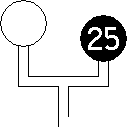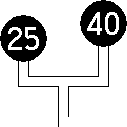|
|
|
|
|
|
For various reasons, although mainly because of track geometry (curvature, etc.), it is necessary to limit the speed at which trains may travel over certain sections of the railway. These places are subject to what are termed 'permanent speed restrictions' (PSRs). In some instances, different speeds are specified for specific types of trains. See Section 16 for speed restriction signs associated with level crossings.
In the early years, most railways did not bother to install lineside signs to indicate a change in the permitted speed but relied on the drivers' knowledge of the road. Two railways that did, however, were the Great Western Railway and the North British Railway. Both companies provided worded notice boards at the beginning of the restriction stating the maximum speed to be observed [13.1 & 13.2]. Boards were also provided at the terminating point of the speed restriction, where normal line speed may be resumed [13.3 & 13.4].
 |
 |
|
[13.1] Speed Restriction Board.
Area: GWR Usage: Unknown Status: Historical |
[13.2] Speed Restriction Board.
Area: NBR Usage: Unknown Status: Historical |
|---|---|
 |
 |
|
[13.3] End of Speed Restriction Board.
Area: GWR Usage: Unknown Status: Historical |
[13.4] End of Speed Restriction Marker.
Area: NBR Usage: Unknown Status: Historical |
Some permanent speed restrictions on the London & South Western Railway were indicated by signs quite similar to those more commonly associated with temporary speed restrictions (see Section 14). An 'outer speed warning indicator', bearing a white triangle on a black background [13.5], was erected on the approach to the start of the speed restriction. The actual commencement of the restriction was denoted by a white circular indicator bearing a letter "C" [13.6]. A similar indicator with a letter "T" marked the terminating point of the speed restriction [13.7]. Although no speed value was exhibited at any of these signs, they provided drivers with a reminder of the location of permanent speed restrictions. Several of these indicators were removed in 1931.
 |
 |
 |
|
[13.5] Outer Speed Warning Indicator.
Area: L&SWR Usage: Medium Status: Historical |
[13.6] Speed Commencement Indicator.
Area: L&SWR Usage: Medium Status: Historical |
[13.7] Speed Termination Indicator.
Area: L&SWR Usage: Medium Status: Historical |
|---|
In early 1905, the Great Western Railway decided to remove all its speed restriction boards (see [13.1 & 13.3]) because their details were published in the Working Time Tables and Sectional Appendices. From 1908, however, the GWR provided illuminated speed indicators [13.8] at certain places where it was felt desirable to do so, e.g. where there was no distinctive physical landmark to identify the location of the speed restriction. At diverging junctions, two indicators were provided, with the indicator applicable to the lower speed diverging route being bracketed to the left or right of the main indicator as appropriate and mounted lower down. If there was no speed restriction on the main route, the higher indicator was blank [13.9]; otherwise, it also showed a speed [13.10].
 |
 |
 |
|
[13.8] Speed Restriction Indicator.
Area: GWR Usage: Unknown Status: Historical |
[13.9] Speed Restriction Indicator applicable only to diverging route (e.g. on right).
Area: GWR Usage: Unknown Status: Historical |
[13.10] Speed Restriction Indicators applicable to main route and diverging route (e.g. 40 mph on straight route and 25 mph on diverging route to left).
Area: GWR Usage: Unknown Status: Historical |
|---|
A unique feature of the junction signalling arrangements in the LNER's colour light signalling installation between London Marylebone and Neasden in 1923 was the provision of selective illuminated speed indicators. These indicators were provided because splitting distant signals (see [6.6]) were considered at the time to be incompatible with three-aspect signalling. Two indicators were installed, one on the Up Main line at Marylebone Goods and the other on the Down Main line at Neasden South. Each indicator was equipped to show two different speed values. Normally just the lower speed was displayed, the higher speed being displayed instead only when the junction beyond was set for the appropriate route and the relevant signals were cleared. The illuminated display presented a similar appearance to the illuminated speed restriction indicators on the GWR (see [13.8]).
From c.1938, the LNER began installing signs at the lineside to remind drivers of the locations of permanent speed restrictions. The signs, which were generally placed about 100 yards (91 metres) before the commencement of each speed restriction, comprised white 'cut-out' figures [13.11]. Where the restriction applied over a diverging line, a white arrow was placed below the figures [13.12] or, where the same speed applied over divergences on either side, two arrows were fitted [13.13].
 |
 |
 |
|
[13.11] Speed Restriction Sign.
Area: LNER (subsequently All Areas) Usage: High Status: Historical |
[13.12] Speed Restriction Sign with Directional Arrow (e.g. applicable to left-hand divergence).
Area: LNER (subsequently All Areas) Usage: High Status: Historical |
[13.13] Speed Restriction Sign with Directional Arrows applicable to divergences in both directions.
Area: LNER (subsequently All Areas) Usage: High Status: Historical |
|---|
|
Some of the speed restriction signs installed at London King's Cross carried a letter after the speed figures [13.14] to denote which line they applied to. The letters corresponded with the designations of the lines on the west side of the approach to the station, known as "A" route to "E" route, and with the identification letters fitted to the signals in that area (see [8.8]). |
|
In 1949, the Railway Executive considered the question of whether permanent speed restrictions should be marked at the lineside and recommended:
"that indication signs be provided on the lineside at the commencement of restriction at places (1) where there are no landmarks to identify positions and (2) where there has been experience of persistent excessive speeds."
The above recommendation was considered but not acted upon, although a few illuminated signs were installed to meet special circumstances. Selected permanent speed restrictions on the Southern Region were marked at the lineside by indicators at the point of their commencement and termination, exhibiting a triangle [13.15] and a letter "T" [13.16], respectively. These indicators were illuminated at night. They were taken permanently out of use in January 1963.
 |
 |
|
[13.15] Speed Restriction Commencement Indicator.
Area: Southern Region Usage: Medium Status: Historical |
[13.16] Speed Restriction Termination Indicator.
Area: Southern Region Usage: Medium Status: Historical |
|---|
On 23 January 1955, a derailment occurred at Sutton Coldfield, causing the deaths of seventeen people. An express train, which had been diverted from its usual route, derailed at a speed of around 60 mph on a curve restricted to 30 mph. As a recommendation of the Ministry of Transport's report into the accident, British Railways reconsidered the provision of speed restriction signs, and in 1957 it decided to adopt the ex-LNER system (see [13.11 - 13.13]) as standard across the whole network.
In 1963, following what had been an exceptionally cold winter, BR took the decision to re-paint all cut-out speed restriction signs yellow to improve their visibility in snow [13.17 - 13.20].
The speed restriction signs with route identification letters at London King's Cross (see [13.14]) and the terminating point markers on ex-NBR lines (see [13.4]) were also painted yellow at that time [13.21 & 13.22].
|
A 'blanket' speed restriction applies over all lines within a complex track layout. A speed restriction sign applicable to a blanket speed restriction carries a supplementary board with the words "all lines" or "all routes" [13.23]. |
|
|
|